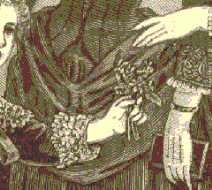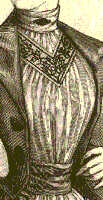| INDEX | 1300-1599 | 1600s | 1700s | 1800s | 1900s | CROSS-ERA | ETHNO | |
| MISCELLANY | CONTACT | SEARCH | |
If you haven't read part one about fashion change yet, I strongly recommend you do so for better understanding.
 tight, long apron of 1878 |
The overpowering feature of the last quarter of the 19th century throughout the Western World is certainly the Industrial Revolution. This calls to mind proletarianism, poverty, and Marx, so at first glance it might be hard to see what it has to to with decidedly upper-class fashion such as we are dealing with here. I sould have mentioned it before: Whatever were're talking about here has nothing to do with the common folk that laboured in factories. Fashion was a private performance of the well-to-do until about the 1920s.
So we are talking here of the bourgeoisie, the new class that was neither noble nor poor and were the trend-setters of that era. Their wealth came, for the most part, from the factories they ran and owned, or from high education jobs that let them take part in the new industrial boom. In that they were different from the nobility, whose wealth was inherited. So the bourgeoisie on one hand imitated the nobility by showing off, and stressed their being different in that they had - more or less - earned their wealth. In this context, fashion played a role in the establishment of the identity of this new class which, by way of being new, had no tradition and no fixed identity. The lack of identity is probably why the bougeoisie envied (thus, imitated) the nobility while at the same time looking down their noses at them.
 loose, short apron of 1888 |
Protestant work ethic and impression management working together, men's apparel became duller than ever before: A businessman had to appear serious and reliable in serious and straightforward clothes. One just did not wear bright coulours and playful patterns. But then how could they show off their wealth, if precious silk and lace and gold buttons were out of style? Well, by letting the ladies dress all the more luxuriously!
Only in the 19th century with its conservatism and romanticism was the idea of women belonging in the house and nowhere else developed. A society made up mainly of hard-working peasants and artisans would never even have dreamed of dispensing with the working power of half the population.
Now women were perceived as having exactly two functions: a) to bear children, and b) to represent. Doing sensible things was decidedly out of the question. Only lowerclass women worked, so if a family didn't want to be counted among them, the wife had to stay home and have servants for the dirty work.
As women weren't taken serious, they didn't have to wear "serious" clothing. On the contrary, they had to be beautiful and spend their days idling in order to demonstrate that their husband earned enough to do without her working. (See Thorstein Veblen's Theory of the Leisure Class). If they did any work at all, it was to be a mere time-killer and as un-productive as possible, e.g. embroidery.
 seemingly loose-fitting taille, late 1880s |
The immensely impractical clothes with their wide and back-breakingly heavy skirts and constricting corsets stressed their demonstrative idleness while at the same time showing off the large amount of expensive cloth they could afford. When the crinoline went out of fashion and skirts ceased to be wide, they became no less impractical - now, they were too tight. Instead of sheer amount of expensive cloth spread all around, the garniture spoke of the amount of expensive work that had gone into folding, embroidering, lace-making and decorative inventiveness. The garniture with its playfulness also had another function: To express and prove the alleged non-serious, playful, unstable, vain nature of women.
As the overall political and social setup in any of the leading countries
and the attitude towards women didn't change until the early 20th century,
the messages contained in clothing didn't change either - only the way in
which they were expressed.
However, from about the 1880s on we see more and more female garments that clearly imitate men's clothing. Examples: Double-breasted jackets with revers (lapels), paletots that imitate curaways, blouses that imitate shirts. The "Revised Trickle Down Theory" developed by Grant McCracken (see Sociology Page) gives an explanation that deserves some thought... Now I think I have to explain what the original Trickle Down Theory is for the sake of those who haven't studied the sociology of fashion. In short, it says that new fashions are invented by the upper class because it wants to stress its being different from lower classes by way of dressing differently, are adopted by the next lower class as it strives to imitate the upper class, then by the next lower class - hence the name "trickle down". The upper class then has to invent a new fashion to maintain the difference (chase-and-flight).
The revised version says that it's not necessarily the upper class that's imitated, but more generally those that have more power. In the 19th century and, to some extent, until our day, men have had more power than women, so they are imitated by women in the hopes of obtaining a share of the power. One of the means of expressing power is clothing in an according way: serious, square, straight clothing. Dressed to impress.
If we apply this Revised Trickle-Down Theory to the late 19th century, we find that as the ideas of women's lib got stronger, more and more traits of male fashion entered female clothing in an attempt to get a share of the power expressed therein. This seems a contradiction - and it is. The female rights movement has from its inception been caught in the dilemma of "different but equal", and "equal as in 'not being different'".
So male fashion was "chased" by female fashion and stressed the traits associated with power even more: squarer, straighter, heavier. Women's clothing followed... if you look down the timeline of female "business clothing" from the end of the 19th century until today, you'll see the mechanism at work. I have to say, however, that during the 1980s the development changed direction somewhat - men's clothing became lighter and more colourful. Can we say that it imitated female fashion for a change?
Content, layout and images of this page
and any sub-page of the domains marquise.de, contouche.de, lumieres.de, manteau.de and costumebase.org are copyright (c) 1997-2022 by Alexa Bender. All rights reserved. See Copyright Page. GDPO
This work is licensed under a Creative Commons License.